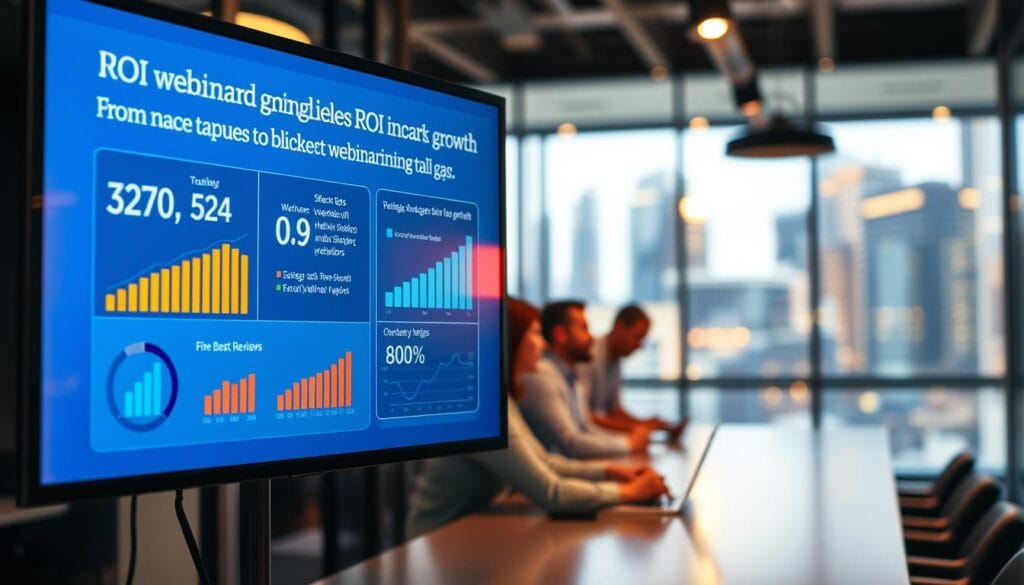Only half of marketers can confidently track ROI — and that gap costs high-ticket brands real revenue every quarter.
We build systems that turn each webinar into a predictable growth engine, not a vanity play. Finance demands clarity: measurable customer acquisition, retention, and a clear path to 3:1–4:1 ROAS.
Our approach defines what matters: conversion efficiency, model-assisted attribution, and centralized data that aligns marketing with the boardroom.
Across events, small changes in registration, engagement, and follow-up lift performance by ~30% when A/B testing and clean analytics are in place. We guide premium brands to shift from scattered activity to scalable assets that compound value and lifetime revenue.
Read on for step-by-step measurement setups, conversion architecture, and governance your finance team will approve — so every event ties to leads, revenue, and long-term growth.
Key Takeaways
- Less than 50% of teams track ROI confidently; measurement wins competitive advantage.
- Focus on conversion efficiency and model-assisted attribution for investor-grade outcomes.
- Benchmarks: aim for 3:1–4:1 ROAS and 2–5% site conversion as realistic targets.
- Structured A/B testing and centralized analytics can lift performance near 30%.
- We convert events into scalable assets that compound leads, revenue, and CLV.
Hook: The ROI Gap Holding Back High-Ticket Webinar Growth
We see the gap that holds high-ticket brands back. Teams obsess over impressions while finance asks for acquisition, retention, and clear numbers.
From vanity metrics to revenue metrics
Impressions, likes, and views are distracting. They do not map to customer lifetime value or cost per acquisition.
- Only ~50% of teams can track roi confidently.
- Last-click models can over-assign up to 40% of credit to bottom-funnel channels.
- Attribution conflicts affect roughly 35% of conversions across platforms.

The 2025 reality: privacy and model-assisted tracking
Privacy shifts like Google’s Privacy Sandbox change tracking but raise user trust by ~41%. That makes first-party data and model-assisted attribution mandatory.
| Metric | Risk | Impact | Fix |
|---|---|---|---|
| CPL/CPA | Unstable cross-channel reads | Inflated costs | UTM taxonomy + centralized analytics |
| Attribution | Last-click bias | Misallocated budget | Model-assisted attribution |
| Engagement metrics | Vanity focus | Poor spend decisions | Link to revenue outcomes |
Webinar Marketing ROI: Definitions, Formulas, and Benchmarks That Matter
We calibrate clear financial formulas so every event shows up as verifiable revenue. This section gives concise definitions, the math you can trust, and finance-approved benchmarks.
Simple vs. accurate ROI formulas
Simple ROI = (Sales Growth – Marketing Cost) / Marketing Cost. Use this for quick directional checks.
Accurate ROI = (Sales Growth – Avg. Organic Sales Growth – Marketing Cost) / Marketing Cost. This isolates true channel impact and removes noise from organic gains.
Core revenue metrics finance cares about
- ROAS: Revenue / Ad Spend — target 3:1–4:1 for profitable channels.
- CPL vs. CPA: CPL = cost per lead; CPA = cost per acquisition. Use CPL for lead funnels and CPA for closed sales math.
- CLV: Customer lifetime value sets your max CAC. A 5% retention lift can >25% profit improvement.

What good looks like
| Metric | Benchmark | Why it matters |
|---|---|---|
| ROAS | 3:1 – 4:1 | Profit signal for channel allocation |
| Site conversion | 2% – 5% (B2B) | Controls lead volume and cost per lead |
| Retention impact | +5% retention ⇒ >25% profit lift | Increases CLV and lowers payback period |
“Finance trusts clear formulas more than flashy engagement numbers.”
Set Up Measurement Right: Goals, UTM Tracking, and Multi-Touch Attribution
Before a single ad runs, we lock measurement so every touch maps to value. This means defining conversion goals, enforcing naming standards, and proving impact to finance.
Google Analytics goals are limited and purposeful: registration, demo requests, pricing-page visits, and key session events. Cap goals under 20 and map each to a revenue moment.
UTM taxonomy and testing
Use standard UTM fields: source, medium, campaign, term, content. Log every tag centrally and run pre-launch tests to prevent misattribution.
Centralized analytics stack
Consolidate site, CRM, platform, and payment data into one stack. Standardize CPA, ROAS, and CLV so executive reporting is unambiguous.
Move beyond last-click
Adopt model-assisted attribution to allocate credit across 6–10 touchpoints. Resolve cross-domain and cross-device gaps with consistent IDs and server-side tracking.
- Define GA goals that map to revenue moments and lock governance.
- Enforce UTMs across email, social, and ads for fast channel comparisons.
- Centralize data for one source of truth and real-time dashboards.
Drive Registrations Efficiently: Channels, Timing, and Cost Controls
We structure promotions so registrations scale predictably across paid and organic channels. Our playbook focuses on high-impact, time-bound tactics you can deploy this quarter.
Email campaigns rely on tight segmentation. Send tailored invitations, a two-step reminder series, and a final-day urgency note. Segments tied to buyer role and intent increase registration and live attendance.
Social media becomes a conversion channel when we use teaser clips, speaker authority, and clear bonus assets. Promote topic teasers and downloadable incentives to spur immediate sign-ups.
Schedule with intent. Test Tuesdays and Thursdays and stack time slots across buyer time zones. Nearly 60% of B2B events run those days—validate morning, lunch, and afternoon windows for your audience.
- Capture late demand: keep paid and organic pushes active—22% register in the last week and 4% on the day.
- Lower cost per lead: A/B test headlines, creative, and offers. Rotate platforms to arbitrage CPM and CPC differences.
- Convert registration to revenue: align sessions to pipeline needs and set SLAs with sales for timely follow-up.
Design Webinars That Convert: Engagement Architecture for Higher Sales
Attention is a scarce asset; we turn audience focus into measurable commercial progress with small, timed interactions.
Script spikes every 5–7 minutes: a poll, a chat prompt, or a micro-activity. These micro-interactions stabilize attention curves and cut drop-off.
Attention curves, polls, and Q&A: reading the room with engagement metrics
Track poll participation, Q&A volume, and question themes to gauge resonance.
Use adjusted attendance rate = (Attendees Live or Replay / Registrants) × 100 to compare sessions fairly. Monitor average watch time per attendee as a primary engagement proxy.
CTA strategy: placement, frequency, and in-session offer framing
Design CTAs as a journey: an early agenda CTA, a mid-session case CTA, and a closing explicit offer.
Make clicks frictionless. Use on-screen buttons, shortened links, and clear value statements that match the current segment.
Measure what moves revenue: CTA CTR, watch time, adjusted attendance rate
Prioritize three metrics: CTA CTR, average watch time, and adjusted attendance rate. These correlate most directly with conversion and downstream performance.
- Feed poll answers into lead scoring to flag demo-ready prospects.
- Vary speakers and add product walkthroughs to convert curiosity into action.
- Package and publish replays within two hours to extend the buying window.
We translate engagement science into revenue outcomes by measuring what matters and designing sessions that push value, intent, and conversions in real time.
Turn Attendees into Pipeline: Lead Qualification, Handoffs, and Nurture
Fast, data-rich handoffs turn engaged attendees into high-propensity leads. We design a tight playbook that prioritizes speed-to-lead, context, and measurable conversion.
In-session qualification
Use targeted polls to surface intent. Ask direct questions like “Do you want to see a demo?” and “What is your main challenge?”
Capture role, budget window, and pain points. Tag answers and Q&A entries so each attendee profile holds rich data for sales.
Post-event follow-up within 24 hours
Send a tailored email within 24 hours with replay, deck, and a clear next step. Separate high-intent leads from nurtures and apply distinct sequences.
We route demo requests instantly and place evaluators into timed nurture that aligns with campaigns and conversion goals.
Sales alignment and SLAs
Pass watch time, poll answers, CTA clicks, and behavior to reps. Pre-briefed sales teams run consultative outreach with context-rich metrics.
- Real-time routing for demo-intent attendees; response within minutes.
- Scheduled follow-ups for evaluators within 24 hours.
- Track conversion from attendee to opportunity to closed-won and tighten offers and cadences.
Compound Returns Post-Event: Content Repurposing and Channel Analytics
After the live session ends, the work that follows determines long-term value. We turn the recording into a systematic content engine that feeds demand, nurtures leads, and proves return.
Launch fast. Publish an on-demand replay within hours, embed short clips into nurture emails and pillar blogs, and upload full recordings to YouTube and partner platforms.
On-demand replays, embedded clips, and distribution
Repurpose aggressively. Create short social snippets, highlight reels for sales, and transcript-based articles. Each asset targets a specific buyer stage and extends attendance into asynchronous leads.
Channel-by-channel ROI and performance tracking
Compare channels on unified CPA, ROAS, and CLV in a single dashboard. Track replay view-through and CTA CTR so pipeline is attributed to post-event consumption — not just live attendance.
| Channel | Typical CPA | Key Metric | Best Use |
|---|---|---|---|
| Email nurture | $15–$60 | Replay view-through | Warm lead conversion and cross-sell |
| YouTube / organic | $5–$30 | Watch time & CTA CTR | Top-of-funnel discovery and long-tail leads |
| Paid social clips | $40–$200 | CPA & short-form engagement | Rapid acquisition and retargeting pools |
| Partner syndication | $25–$120 | New-account CLV | Buying-committee reach and late-stage influence |
Standardize dashboards and automate tracking so we spot wasted spend and shift budgets in real time. This protects investment and compounds return across media, channels, and platforms.
Conclusion
Every event should prove its value in dollars and pipeline, not just applause.
We recenter the mission: measure what moves money, design for conversion, and scale what compounds across live and on-demand sessions. Clean goals, strict UTM rules, model-assisted attribution, and fast handoffs turn engagement into qualified leads and measurable revenue.
Macro Webber’s frameworks and WebberXSuite™ combine first-party data, server-side tracking, and real-time dashboards to accelerate decisions and lift conversion rates toward finance-aligned targets like 3:1–4:1 ROAS and 2–5% site conversion.
Act now: book a strategy consult this week. Limited slots unlock the A.C.E.S. Framework and a projected pipeline lift before you commit.



